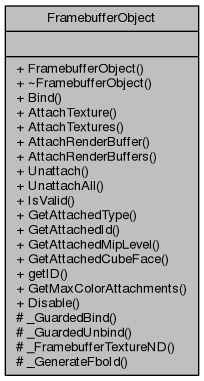|
| | FramebufferObject () |
| | Ctor/Dtor. More...
|
| |
| virtual | ~FramebufferObject () |
| |
| void | Bind () |
| | Bind this FBO as current render target. More...
|
| |
| virtual void | AttachTexture (GLenum texTarget, GLuint texId, GLenum attachment=GL_COLOR_ATTACHMENT0, int mipLevel=0, int zSlice=0) |
| | Bind a texture to the "attachment" point of this FBO. More...
|
| |
| virtual void | AttachTextures (int numTextures, GLenum texTarget[], GLuint texId[], GLenum attachment[]=NULL, int mipLevel[]=NULL, int zSlice[]=NULL) |
| |
| virtual void | AttachRenderBuffer (GLuint buffId, GLenum attachment=GL_COLOR_ATTACHMENT0) |
| | Bind a render buffer to the "attachment" point of this FBO. More...
|
| |
| virtual void | AttachRenderBuffers (int numBuffers, GLuint buffId[], GLenum attachment[]=NULL) |
| |
| void | Unattach (GLenum attachment) |
| | Free any resource bound to the "attachment" point of this FBO. More...
|
| |
| void | UnattachAll () |
| | Free any resources bound to any attachment points of this FBO. More...
|
| |
| bool | IsValid (std::ostream &ostr=std::cerr) |
| |
| GLenum | GetAttachedType (GLenum attachment) |
| | Is attached type GL_RENDERBUFFER_EXT or GL_TEXTURE? More...
|
| |
| GLuint | GetAttachedId (GLenum attachment) |
| |
| GLint | GetAttachedMipLevel (GLenum attachment) |
| | Which mipmap level is currently attached to "attachement?". More...
|
| |
| GLint | GetAttachedCubeFace (GLenum attachment) |
| | Which cube face is currently attached to "attachment?". More...
|
| |
| GLuint | getID () const |
| | END : Static methods global to all FBOs. More...
|
| |
FramebufferObject Class. This class encapsulates the FramebufferObject (FBO) OpenGL spec. See the official spec at: http://oss.sgi.com/projects/ogl-sample/registry/EXT/framebuffer_object.txt
for details.
A framebuffer object (FBO) is conceptually a structure containing pointers to GPU memory. The memory pointed to is either an OpenGL texture or an OpenGL RenderBuffer. FBOs can be used to render to one or more textures, share depth buffers between multiple sets of color buffers/textures and are a complete replacement for pbuffers.
Performance Notes: 1) It is more efficient (but not required) to call Bind() on an FBO before making multiple method calls. For example:
FramebufferObject fbo; fbo.Bind(); fbo.AttachTexture(GL_TEXTURE_2D, texId0, GL_COLOR_ATTACHMENT0_EXT); fbo.AttachTexture(GL_TEXTURE_2D, texId1, GL_COLOR_ATTACHMENT1_EXT); fbo.IsValid();
To provide a complete encapsulation, the following usage pattern works correctly but is less efficient:
FramebufferObject fbo; NOTE : No Bind() call fbo.AttachTexture(GL_TEXTURE_2D, texId0, GL_COLOR_ATTACHMENT0_EXT); fbo.AttachTexture(GL_TEXTURE_2D, texId1, GL_COLOR_ATTACHMENT1_EXT); fbo.IsValid();
The first usage pattern binds the FBO only once, whereas the second usage binds/unbinds the FBO for each method call.
2) Use FramebufferObject::Disable() sparingly. We have intentionally left out an "Unbind()" method because it is largely unnecessary and encourages rendundant Bind/Unbind coding. Binding an FBO is usually much faster than enabling/disabling a pbuffer, but is still a costly operation. When switching between multiple FBOs and a visible OpenGL framebuffer, the following usage pattern is recommended:
FramebufferObject fbo1, fbo2; fbo1.Bind(); ... Render ... NOTE : No Unbind/Disable here...
fbo2.Bind();
... Render ...
Disable FBO rendering and return to visible window OpenGL framebuffer. FramebufferObject::Disable();
Definition at line 107 of file framebufferObject.h.



 1.8.14
1.8.14